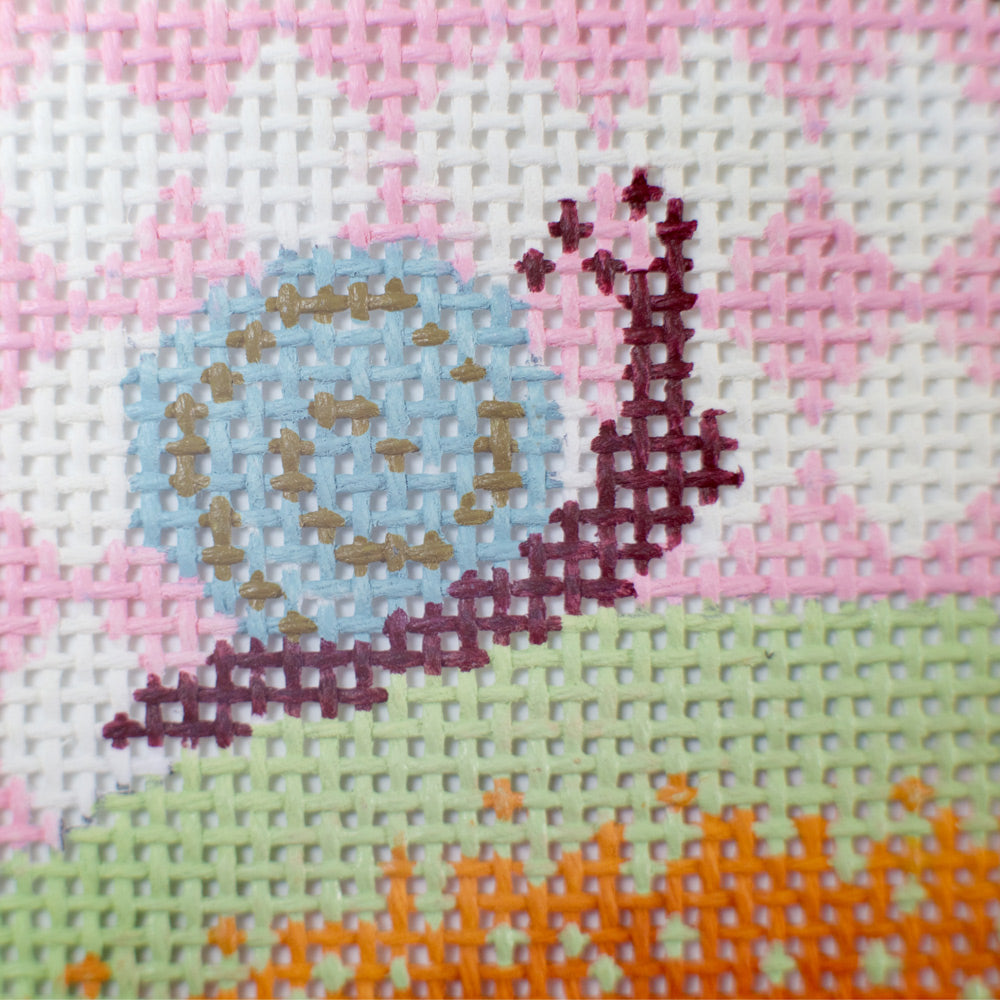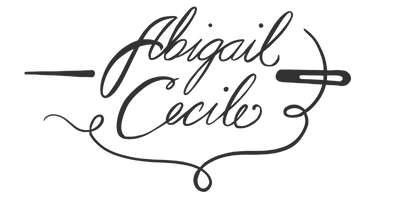Shipping is paused for Christmas from December 23 through January 4. Orders placed during this time will begin shipping out on January 5.
Shipping is paused for Christmas from December 23 through January 4. Orders placed during this time will begin shipping out on January 5.
Finishing
Classes
What Is Needlepoint?

Needlepoint is a type of hand embroidery. Specifically, it is a counted form of embroidery. That means it is stitched on a canvas that has designated holes for your needle to go through (think of it as a grid). Because of the grid like canvas, the stitches are (for the most part) geometric in nature.
How is needlepoint different from typical hand embroidery (the crafty kind you see on Instagram, in craft stores, or in kits and patterns on Etsy?) Well, while you use some of the same materials, like a needle and floss, the stitches and background material are totally different. Typical hand embroidery can be stitched on just about anything. But needlepoint is stitched on an open weave canvas. The stitches are limited by the holes of the grid which determines the types of stitches used. Another difference is that the entire surface area of the canvas is covered by stitching.
The application is different too. Needlepoint canvas is quite stiff, so it’s used to create pillows, home decor, wall hangings, eyeglass cases, bags, Christmas stockings etc.
Ok, let's dive into specifics.
Canvas
While there are several different ways of creating a canvas, the best canvases have their design hand painted right onto the needlepoint canvas. So instead of having an instruction booklet or chart, the canvas itself is your guide and you’ll stitch right over the design.
Canvas comes in different counts or mesh sizes. Typical needlepoint canvas is 10, 13, 16, and 18 count. Each has a different amount of openness, or rather the holes are different sizes. You can also think of it as the amount of holes per inch. On 10 count canvas there are 10 holes per inch and therefore 10 stitches per inch. On 18 count canvas, 18 holes per inch and 18 stitches per inch. More stitches per inch means more detail and finer work. Fewer holes per inch means less detail, bigger, and heavier work. Other factors to consider are:
- Time. It takes longer to stitch eighteen stitches vs. ten. So a ten count canvas will stitch up much faster.
- Thread. To completely cover a canvas with ten holes per inch you are going to need something thick and chunky. At eighteen holes per inch, you'll want to use a thread that is more delicate and fine - something that can easily pass through a much smaller hole (which is very different visually).
By the way, I really enjoy stitching on sixteen count canvas. It stitches up faster than eighteen count but is fine enough for lots of great detail!

Threads
There are so many gorgeous threads to choose from! The threads you use will depend on your design and its ultimate purpose.
There are silks, wools, cotton, synthetic sparkly special effects stuff, fluffy stuff, ribbon…..
How do you choose?
- Appropriateness. If you are stitching something with a smooth surface (let's say a tea cup), choose a thread that will lay flat and well, smoothly. Silk is smooth, so is cotton and bamboo. If you are stitching an animal such as fox, use wool or something even fluffier (something that will look like fur).
- Thickness. Depending on your canvas count you’ll need to choose a thread that will cover your canvas nicely but make it through the holes.
- Application. What is the final application of your piece? A pillow will get a lot of wear, probably not the best project for delicate ribbon work…something hardier like wool would be appropriate. If you’re making a wall hanging, delicate sparkly threads and ribbon are just fine.

Frames
The needlepoint canvas does not necessarily need to be held in a frame during stitching but I almost always use one. Stretcher bars (a type of frame, pictured below) are cheap and easy! Just grab a staple gun (or tacks) and attach your canvas. It will keep the tension of your stitching even and the grid of your canvas square.

Stitches
You have two options when it comes to stitches. The first is to stitch your entire design in basketweave (the car in the picture below is stitched in basketweave). This basic stitch was used extensively in historic needlepoint and is probably it's most recognizable form. The second is to use a combination of stitches across the different areas of your canvas.
A little bit more about basketweave: Basketweave is a traditional, small, diagonal stitch. It gives you an optimal amount of detail. Basketweave can be confusing as it is also called tent stitch. However, basketweave is only one of the three different types tent stitches. All tent stitches look the same on top but are different on the back. Why?..Because they are stitched in different ways.

Otherwise, there are literally thousands of stitches that you can use on a needlepoint canvas! The hard part is choosing stitches that are appropriate for your design. But there are tools that will help you with this:
- Books: There are books that break stitches up into different categories. Let's say you are stitching a flower and looking for an appropriate stitch. You wouldn't want to choose a stitch that has a pattern like a brick wall. The books listed below will have a section on stitches that work well for flowers, for grass, sky, clothing, walls, houses….and on - making it very easy to find an appropriate stitch.
Stitches for Effect Series by Suzanne Howren and Beth Robertson
Stitch Series by Little Shoppe Canvas Company: Ins and Outs, Landscapes, and Winter.
- Finished pieces: Again, if you are stitching a flower - find a picture of a finished needlepoint flower and see what stitches were used. Reach out to stitchers and ask! Social media is great for this, you can join a needlepoint group and get in contact with the original stitcher about the stitch you’re interested in. (BTW, I’m not endorsing buying a canvas and finding a finished picture of that canvas and copying it stitch for stitch, that’s rude).
- Experimentation: Nothing will help you more than trying a stitch for yourself. Grab a piece of scrap canvas and test it out. See if it fits visually, make sure it looks good with the thread you’ve chosen and the size of the area it will be stitched into, and see if you like it...because ultimately that’s what matters.
Instructions
“You mean I don’t get an instruction booklet like everything else in the crafting industry?” Well, sometimes.
Needlepoint is needlework! It has an incredible and long history of beautiful craftsmanship. BUT that doesn’t mean it's complicated or hard. The coolest thing about needlepoint is, the canvas is just the design. It’s up to the stitcher to make it as complicated or simple as they want! The entire piece can be stitched in basketweave…ONE stitch across the entire design. The same piece can be stitched using advanced embroidery techniques and many different stitches. It’s up to the stitcher. And frankly, each has a beauty of it's own.
That being said, if you are set on having an instruction booklet you have several options.
- Buy a kit. Your options are more limited, but there are some gorgeous kits available.
- Buy a canvas that comes with a stitch guide. A stitch guide is an instruction booklet for a specific canvas. Experienced needle pointers will decide which stitches and threads they would put on a canvas, stitch it up, create instructions, and sell it alongside the canvas. Not all canvases have stitch guides but quite a few do. Sometimes the stitch guide is included with the canvas, sometimes you have to purchase it separately.
If you are intimidated by needlepoint and it's keeping you from trying this wonderful craft, or if you have any specific questions - I would love to hear from you!
Leave a comment
Comments will be approved before showing up.














